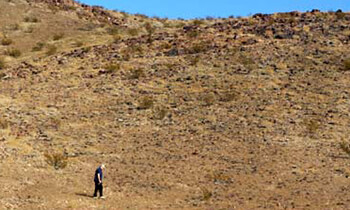The Sidewinder
Horned Rattlesnake

The venomous sidewinder is also called the "Horned Rattlesnake." It is unique because of its sideways form of locomotion with its body moving in an S-shaped curve.
Range
Mojave and Sonoran deserts of southeastern California, western Arizona, southern Nevada and extreme southwestern Utah to Mexico.
Habitat
Often found in arid desert flatlands, loose, sandy washes, hard pan flats and rocky areas below 5,000 feet. Also common among hummocks topped with creosote where kangaroo rats and other rodents burrow.
Description
This sidewinder is light in color -- tan, cream, pink, gray or sandy, with darker patches on its back of gray, yellow or tan. Mature adults grow 18 to 32 inches in length. It also has a dark eye strip extending back along its head.
The sidewinder has rough, keeled scales, which aid in its unique sidewinding locomotion. Its supraoculars (triangular projections over each eye) are pointed and upturned giving them a horn-like appearance --thus its nickname, the horned rattlesnake.
Behavior
The sidewinder travels quickly over desert surfaces using its unique "side winding" locomotion to prey on pocket mice, kangaroo rats, lizards and sometimes birds. Young sidewinders prefer lizards while older ones prefer rodents. Rodents are bitten, released and tracked down, while lizards are held until the venom takes effect.
Life Cycle
Sidewinders mate April through May, sometimes in the fall. Females give birth to 5-18 young late summer to early fall. The young are born 6 to 8" long.
Subspecies
Mojave Desert Sidewinder (C. c. cerastes) has the bottom segment of its rattle brown. It ranges from extreme southwestern Utah, southern Nevada and the Mojave Desert of California.
Sonoran Sidewinder (C.c. cercobombus) has the bottom segment of its rattle black. It ranges from south-central Arizona into Sonora, Mexico.
Colorado Desert Sidewinder (C.c. laterorepens) has the basal rattle segment black. Ranges from southwestern Arizona and southeastern California into Mexico.
-- A.R Royo
Share this page on Facebook:
The Desert Environment
The North American Deserts
Desert Geological Terms







